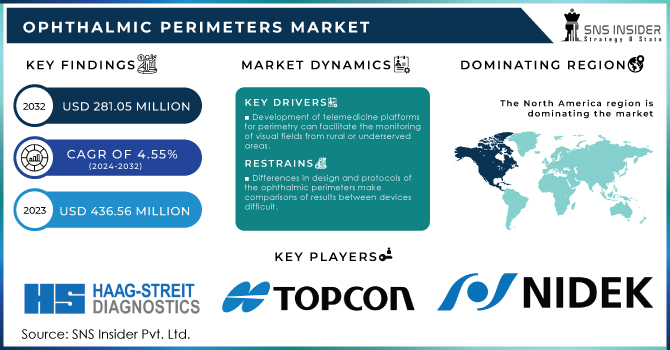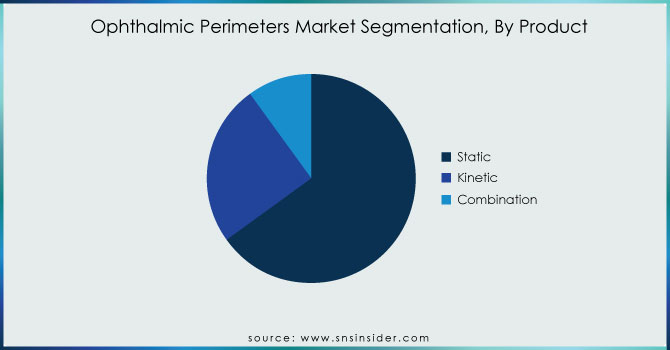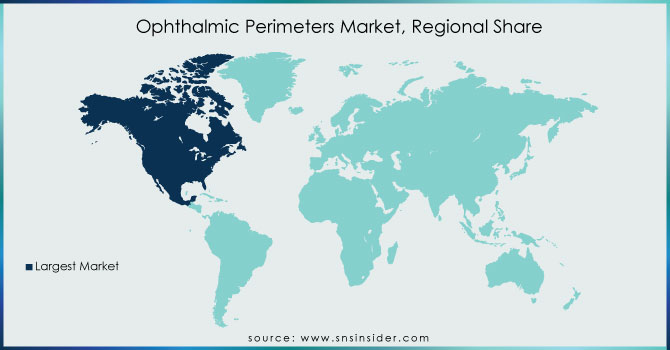Ophthalmic Perimeters Market Report Scope:

Get more information on Ophthalmic Perimeters Market - Request Free Sample Report
The Ophthalmic Perimeters Market size is projected to reach USD 436.56 million by 2032 and was valued at USD 281.05 million in 2023. The market will be growing at a CAGR of 4.55% over 2024-2032.
The ophthalmic perimeters market growth is highly driven by the increasing cases of eye diseases. According to the World Health Organization, globally, 2.2 billion people have near or far distance vision impairment, wherein glaucoma and age-related macular degeneration are leading causes. This rise in eye disorders increased demand for diagnostic tools that are accurate and fast, like ophthalmic perimeters. Again, one of the major driving forces of this market is the aging population of the world, especially in developed nations. The older a person is, the more prone he or she will be to ophthalmic diseases like cataracts, glaucoma, and AMD. It is because of this demographic change that ophthalmic perimeter devices also find higher application in healthcare settings.
The market does possess a lot of untapped opportunities, especially in the emerging economies. This is majorly due to the increasing prevalence of eye diseases, including glaucoma and age-related macular degeneration, as a result of the aging populations and increased life expectancy. The monitor was utilized by over 2.3 million patients in the year 2021. For instance, we can take the rising estimate of glaucoma in India to get to be an prediction of 30% by the year 2030 which means such rising incidences in eye diseases are going to fuel a rising demand for early diagnosis and monitoring, which can be effectively provided by ophthalmic perimeters.
Around 70% of the newly introduced products have several advanced features, such as automated perimeters and digital imaging. Such features of new products improve the accuracy of diagnoses, enhance patients' comfort, reduce testing time, and increase testing productivity. More so, artificial intelligence integrated with the devices will create a new revolution of helping precise visual field analysis and recognizing the signs of glaucoma and other eye diseases way earlier than usual.
Market Dynamics:
Drivers:
-
The rising eye disorders, like glaucoma, macular degeneration, and diabetic retinopathy, with increasing age act as key drivers of the ophthalmic perimeters market.
-
Advances in technology for the invention of more accurate, efficient, and user-friendly ophthalmic perimeters majorly contribute to the growth of the market.
-
Development of telemedicine platforms for perimetry can facilitate the monitoring of visual fields from rural or underserved areas.
In addition, the practice of ophthalmology has exponentially reached out due to teleophthalmology particularly in communities, where eye specialists are scarce. Patients in the rural area can now perform regular consult and testing of the eye through visual field test conveniently because they do not have to be transported or travel far to go to another area. This benefits the underserved communities, and about 30% of patients perform visual field testing satisfied for their needs.
Remote monitoring seeks to detect at the earliest possible stage any eye diseases such as glaucoma and diabetic retinopathy. When such conditions are detected earlier, medical practitioners can intervene as quickly as possible and hence avert loss of vision. Under the teleophthalmology system, only 75% of patients diagnosed with glaucoma showed a disease progression rate slower than patients diagnosed under the traditional in-person-visit system.
Restrains:
-
Differences in design and protocols of the ophthalmic perimeters make comparisons of results between devices difficult.
-
A relatively high-cost piece of equipment because of the sophisticated features loaded into ophthalmic perimeters, making the advanced models an expensive buy and to maintain, therefore access is limited especially in resource-restrained healthcare settings.
Especially the latest models, which have many features, can be very expensive and, therefore, out of the reach of many healthcare facilities with small budgets. This disparity is very significant, especially in developing countries, where the health budget is normally strained. For instance, according to a report recently released by the World Health Organization, less than 25% of health facilities in low-income countries have access to modern ophthalmic perimeter equipment. This lack of access may therefore delay the diagnosis and treatment of eye diseases such as glaucoma and diabetic retinopathy, leading to preventable blindness.
Key Segments Analysis:
By Product
Static perimeters the most conventional product type feature a fixed target at which the patient looks. Conventional static perimeters accounted for about 65% of the market in 2023, primarily because they are cost-effective and established. Kinetic perimeters, on the other hand, are capable of providing a moving target and thus a more dynamic test. They held 30% of the market because they are capable of detecting the even minutest defects within the visual field.
With regards to the combination perimeter, it is the best of static and kinetic testing combined in one perimeter. Versatility in application due to its dynamic state gives it a 5% share of the market. This perimeter, by far one of the most expensive, will continue to have increased usage due to further technological improvements, and it will become more practical for greater pathology than currently exists, providing complete visual field assessment.

Get Customized Report as per your Business Requirement - Request For Customized Report
By Application:
Glaucoma held the biggest share, valued at approximately 65% of the market in 2023. This can be attributed to the growing prevalence of glaucoma, particularly open-angle glaucoma, which usually remains asymptomatic until substantial visual field loss has already occurred. That is why early detection and monitoring by means of an ophthalmic perimeter are very important in order to prevent vision impairment and blindness from glaucoma. The second application, which is the largest, is cataract, with about 20% of market share. Though surgical treatment of cataracts is the most prominent one, ophthalmic perimeters have a significant role in pre-operative assessment and post-operative monitoring for any change in visual field.
Dry eye is another growing area of application, which accounted for 10%. With increasing awareness about dry eye syndrome, ophthalmic perimeters are used to assess the impact of the condition on visual field and monitor treatment effectiveness. The remaining 5% comprises other applications in retinal diseases and optic nerve disorders.
By End Use:
Having a comprehensive infrastructure and wide arrays of specialties, 75% of the market was captured by hospitals in 2023. This is due mostly to their greater capacity for complicated cases and more extensive diagnostic and treatment possibilities. With further specialization in the care of the eye, ophthalmic clinics accounted for 20%. Lastly, the final 5% was captured by other organizations or private practice.
Key Players:
The Major Players are Haag-Streit Ag, Topcon Corporation, Nidek Co Ltd, Heidelberg Engineering GmbH, Optopol Technology Sp, Takagi Seiko Co Ltd, Kowa Company Ltd, Metrovision, Konan Medical USA, Centervue S.PA and Other Players
Regional Analysis:
North American region dominated the market in 2023, especially the U.S., in the ophthalmic perimeters market. Major factors, such as the large and aging-supra-aged population, advanced healthcare infrastructure in the region, and major players being positioned in major markets of North America region. According to the Centers for Disease Control and Prevention, it is estimated that glaucoma will affect about 3.4 million people in the United States, where most of these cases are the ones that perimeter testing should be carried out at regular intervals.
Besides, there is a well-established structure of ophthalmology clinics and hospitals with the latest perimeter devices in this region, thus coverage and positive rate of adoption. The high adoption rate of advanced technologies, such as automated perimeters and cloud-based platforms, has, in turn, contributed to boosting the growth of this market in North America.

Recent Developments:
- Zeiss Medical Technology:
Partnership with European Association of Neurosurgical Societies (EANS): In October 2022, Zeiss announced a strategic collaboration with EANS to advance the use of ophthalmic perimeters in neuro-ophthalmology.
The company has consistently introduced new ophthalmic perimeter models with advanced features and capabilities.
- Revenio Group:
Acquisitions: Revenio has grown its market presence through acquisitions of smaller ophthalmic perimeter manufacturers.
Product Integration: The company has focused on integrating ophthalmic perimeters with other diagnostic tools in its portfolio to provide comprehensive eye care solutions.
| Report Attributes | Details |
|---|---|
| Market Size in 2023 | USD 281.05 Million |
| Market Size by 2032 | USD 436.56 Million |
| CAGR | CAGR of 4.55% From 2024 to 2032 |
| Base Year | 2023 |
| Forecast Period | 2024-2032 |
| Historical Data | 2020-2022 |
| Report Scope & Coverage | Market Size, Segments Analysis, Competitive Landscape, Regional Analysis, DROC & SWOT Analysis, Forecast Outlook |
| Key Segments | • By Product: (Static, Kinetic, Combination) • By Application: (Dry Eye, Cataract, Glaucoma, Others) • By End Use: (Hospitals, Ophthalmic Clinics, Others) |
| Regional Analysis/Coverage | North America (US, Canada, Mexico), Europe (Eastern Europe [Poland, Romania, Hungary, Turkey, Rest of Eastern Europe] Western Europe] Germany, France, UK, Italy, Spain, Netherlands, Switzerland, Austria, Rest of Western Europe]), Asia Pacific (China, India, Japan, South Korea, Vietnam, Singapore, Australia, Rest of Asia Pacific), Middle East & Africa (Middle East [UAE, Egypt, Saudi Arabia, Qatar, Rest of Middle East], Africa [Nigeria, South Africa, Rest of Africa], Latin America (Brazil, Argentina, Colombia, Rest of Latin America) |
| Company Profiles | Haag-Streit Ag, Topcon Corporation, Nidek Co Ltd, Heidelberg Engineering GmbH, Optopol Technology Sp, Takagi Seiko Co Ltd, Kowa Company Ltd, Metrovision, Konan Medical USA, Centervue S.PA |
| Key Drivers | The rising eye disorders, like glaucoma, macular degeneration, and diabetic retinopathy, with increasing age act as key drivers of the ophthalmic perimeters market. |
| RESTRAINTS | Differences in design and protocols of the ophthalmic perimeters make comparisons of results between devices difficult. |

